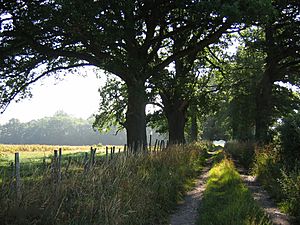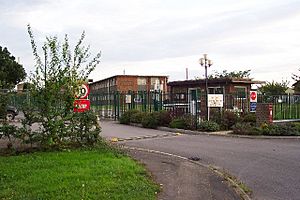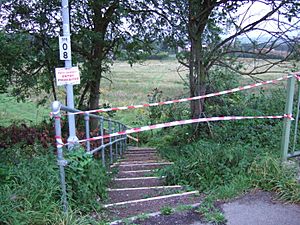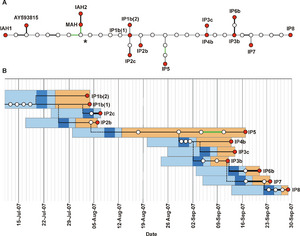2007 United Kingdom foot-and-mouth outbreak facts for kids
The 2007 United Kingdom foot-and-mouth outbreak happened when a dangerous liquid from a lab in Surrey caused foot-and-mouth disease (FMD) in animals. This disease affected four farms nearby. Experts from the Department for Environment, Food and Rural Affairs (Defra) found the infections through regular animal checks.
The first case was found in Normandy, Surrey. Three days later, a second case appeared in Elstead. The next day, a third infection was found close by. About a month later, a final case was found 13 miles north of the first one. The virus came from old pipes at either the Institute for Animal Health or the Merial Animal Health lab near Pirbright village. Both labs worked on vaccines. Investigators found problems with these pipes. An expert, Brian Spratt, believed the pipes likely leaked the virus. Both labs fixed their waste systems to keep working. The UK government paid the affected farmers for their losses.
Because of these events, special zones were set up in three counties. Countries like Canada and the Republic of Ireland temporarily stopped buying meat and dairy from the UK.
Contents
What is Foot-and-Mouth Disease?
Foot-and-mouth disease (FMD) is a serious illness for animals with split hooves. This includes cows, pigs, sheep, and goats. It causes fever and blisters in the mouth and on the feet. The disease spreads very easily between animals. It can cause big problems for farmers and the economy.
Past Outbreaks in the UK
The United Kingdom had a foot-and-mouth outbreak in 1967. That one was mostly in an area near the Welsh border. A much bigger crisis happened in 2001. That outbreak spread across most of Britain. It caused huge losses for farmers and hurt tourism. About 2,000 farms were affected. People were still worried about the disease in 2007.
How the 2007 Outbreak Started
First Signs of Disease
On August 2, 2007, signs of foot-and-mouth disease were first seen. This was on a farm in Normandy, Surrey. The farm was quickly closed off. The next day, Chief Veterinary Officer Debby Reynolds confirmed the disease. Initial tests showed 60 cows were infected.
On August 4, the virus was identified. It was a specific type called FMDV BFS 1860 O1 1967. This exact virus was first found in the 1967 outbreak. It had not been seen in animals since then. This virus was the same type used at the nearby Pirbright lab sites. These sites housed the Institute for Animal Health (IAH) and Merial Animal Health Ltd. They were only about 2.5 miles away.
The Institute of Animal Health at Pirbright studied foot-and-mouth disease. The Merial Animal Health site was also a possible source. They were one of only four labs in Europe allowed to handle this virus type. They used it to make vaccines. Because these labs were so close, the safety zone around the farm was made larger.
On August 5, another protection zone was set up near Elstead. This was after a cow at another farm location tested positive. All animals at both locations were already put down as a safety step. The next day, more animals in a protection zone showed FMD symptoms. They were also put down. Tests confirmed FMD on a farm in Surrey. The cows were on land rented by a farmer to a neighbor.
Lab Safety Concerns
On August 7, the Health & Safety Executive (HSE) released a report. It said it was very likely the virus came from the IAH or Merial sites. The report looked at how the virus might have escaped. It said it was unlikely the virus spread through the air. It also said it was unlikely to have spread by floodwater. The report suggested that people moving from the lab could have carried the virus.
The Pirbright site had caused foot-and-mouth outbreaks before. In 1970, the virus escaped there. Eighteen animals had to be put down then.
Later Cases and Control
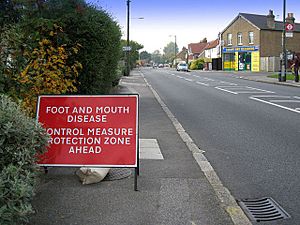
On August 9, a farmer whose cows had been near the first outbreak reported some of his animals. A temporary control zone was set up. It was removed on August 11 after tests were negative. Three other possible outbreaks were checked in August. These were at another farm in Surrey, at Chessington World of Adventures zoo, and a farm in Kent. All tested negative. On August 24, Defra removed the protection zones. The wider surveillance zone was removed on September 8. A 5 km safety area stayed around the Pirbright labs for longer.
A new case of foot-and-mouth was found on September 12. This was at Milton Park Farm near Egham, about 30 miles north of the first case. A new protection zone was set up around this farm. A sick sheep in Scotland was later found to be negative. Also, a temporary control zone was put around a place in Norfolk. This was a safety step. Tests for these animals were also negative, and restrictions were lifted.
Safety Measures Taken
All animals at the three affected farms were put down on August 4. A national ban was placed on moving cows and pigs. A 3 km protection zone was set up around the affected farm. A larger 10 km zone was created for checking animals. An 8 km air exclusion zone was also put in place.
The United Kingdom also stopped exporting animal products. This was required by European Union rules.
In total, 2,160 animals were put down during the 58-day outbreak. This included cows, pigs, sheep, and goats. The total cost to control the disease and for animal losses was about £47 million. This was much less than the 2001 outbreak, which cost around £3 billion. In 2001, about four million animals were put down over 221 days.
How People Reacted
Government Reaction
The Prime Minister Gordon Brown and Environment Secretary Hilary Benn came back early from their holidays. Other government leaders also cut short their breaks. A special government meeting was held to discuss the outbreak.
International Reaction
After the outbreak was confirmed, Northern Ireland and the Republic of Ireland closed their ports to livestock and fresh meat from the UK. They also put disinfectant measures in place at ports and airports. Canada stopped all livestock from the UK. Japan and the United States stopped pigs and pig products. British beef was already banned in these countries.
The Investigation
A report on the outbreak was released on September 5, 2007. It found traces of the virus in a pipe at the Pirbright Institute. This pipe went from the Merial lab to the government's waste treatment plant. It was thought that tree roots damaged the pipe, letting the virus escape. The report suggested that workers might have carried the virus to the Normandy farm on their way home.
An independent expert, Brian Spratt, also investigated. He found that the pipes from the IAH and Merial labs were old. They did not seem to be checked regularly. He said it was very likely they leaked the virus. These pipes were supposed to be very secure, like a high-level safety area.
In May 2008, the Surrey County Council decided not to take legal action. They said it was not possible to prove exactly where the virus came from. Also, the two labs shared drainage systems, which made it hard to prove who was responsible.
Media and Safety
Some media photographers tried to get into the restricted areas. Police said this was dangerous because the disease spreads easily. Two photographers were later found guilty for ignoring the rules and entering protected sites.
See also
- 1967 United Kingdom foot-and-mouth outbreak
- 2001 United Kingdom foot-and-mouth crisis
- 2010 Japan foot-and-mouth outbreak



